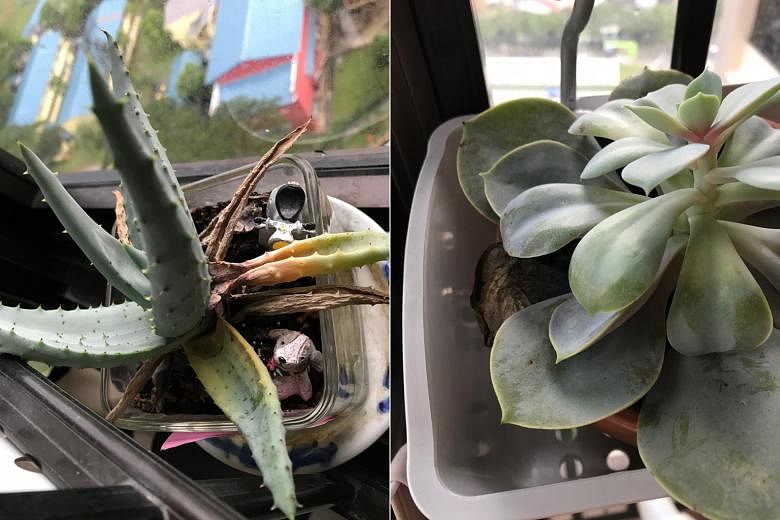Aloe and Echeveria lack light
I would like to know how to care for these plants - they are not doing well, despite my best efforts. I have had the Aloe vera plant (above left) for about six months and some stems have dried up. The other plant (above right) is about two months old. All the leaves at the bottom are rotting and the leaves on top are starting to rot too. How frequently should I water the plants and do they require special care and fertiliser?
Raymond Heng
The Aloe species (above left) is not the common Aloe vera. If you bought it from the commonly available assortment of cacti and succulents at local nurseries, it is probably Aloe peglerae.
The other plant (above right) is botanically known as Echeveria and this is the Perle Von Nurnberg variety.
In both cases, the plants look stretched - this is an indication of a lack of light. Both plant species need at least six hours of direct sunlight to keep their compact, attractive growth forms.
The Aloe is probably suffering from crown rot due to wet growing conditions. In the case of the Echeveria, both good light and cool growing temperature are required for the plant to thrive and retain its vivid coloration.
Local gardeners advise growing the two plants in a well-drained mix and keeping them sheltered from rain. Most growers will remove the highly moisture-retentive mix that often comes with the plants.
They are then grown in a mix containing coarse volcanic sand or pumice. Such a mix will dry out quickly and is more suited for these plants in the tropics.
Depending on your growing conditions, plants need to be watered thoroughly, but the roots must dry out before the next watering to reduce the likelihood of root and crown rot.
Philodendron likely to be sunburnt

I received this potted plant for my housewarming. It was lustrous and I placed it on the outdoor balcony without shelter. Over time, the leaves looked scorched (above). What is the cause for this and the remedy? I have moved the plant to a corner with less exposure to direct sunlight, but its condition has not improved.
Jane Goh
The plant is a Philodendron cultivar. The brown patches and pale green leaves suggest that the plant is sunburnt.
This plant is generally regarded as a species more suited for areas with less intense sunlight.
For now, you may want to move the plant to a location where it gets at least four hours of filtered sunlight. The damaged leaves will not recover, but new leaves will be produced and these will replace the damaged ones in due time.
If there are just a few damaged leaves, you can prune them to maintain the visual aesthetics of the plant.
Giant Dutchman's Pipe is not related to pitcher plant

I saw this unique-looking plant (above) while walking along the sheltered walkway near an Ang Mo Kio bus stop. Does it belong to the pitcher plant or Rafflesia family?
Courtney Ong
The plant is commonly known as the Giant Dutchman's Pipe or Pelican Flower.
It is botanically known as Aristolochia gigantea and is not related to the Rafflesia or the tropical pitcher plant (Nepenthes).
The Giant Dutchman's Pipe is an unusual climber that is suited for a sunny spot in the garden. It requires a large climbing support to grow and climb on.
What you see are the flower buds. The flowers are rather curious-looking and they attract flies, which are its natural pollinators.
Cobweb spiderwort thrives under ample light

What is the name of this plant (above)? I bought it from a nursery, have been growing it for about a year and was pleasantly surprised that it flowered last month. What are the conditions required for this plant to flourish?
Karen Heng
The plant is commonly known as the Cobweb spiderwort. Its botanical name is Tradescantia sillamontana. Unlike many other species of Tradescantia, this variety needs a well-drained mix and can be grown largely under filtered sunshine or exposed to a few hours of direct sunlight.
Under good light, the plant takes on an attractive compact growth habit and the leaves will be covered densely with numerous white threads.
This plant is somewhat drought-tolerant. Hence its roots need to dry out before every watering. Prolonged wet feet can lead to rotting.
Tie Shu may have fungal leaf spot disease

I grow this plant (above) by the window and water it once daily. The pot drains well. The plant gets morning sunlight, but no fertiliser. There are yellowish-brown spots on only a leaf for the past few months. Recently, I saw another tiny spot on the edge of another leaf. What is the cause?
Constance Chan
The plant is commonly and locally known as the "Tie Shu" (which translates to "Metal Tree"). Its botanical name is Dracaena fragrans and this is of the Massangeana variety.
The brown spots may be the onset of a fungal leaf spot disease, which affects young or emerging leaves.
You can prune infected leaves to reduce the spread of the disease. Also, ensure that there is good air circulation around the plant and keep the foliage dry. Use a fungicide such as captan as a preventive measure.
• Answers by Dr Wilson Wong, an NParks-certified practising horticulturist and park manager. He is the founder of Green Culture Singapore and an adjunct assistant professor (Food Science & Technology) at the National University of Singapore.
• Have a gardening query? E-mail it with clear, high-resolution pictures of at least 1MB, if any, and your full name to stlife@sph.com.sg

